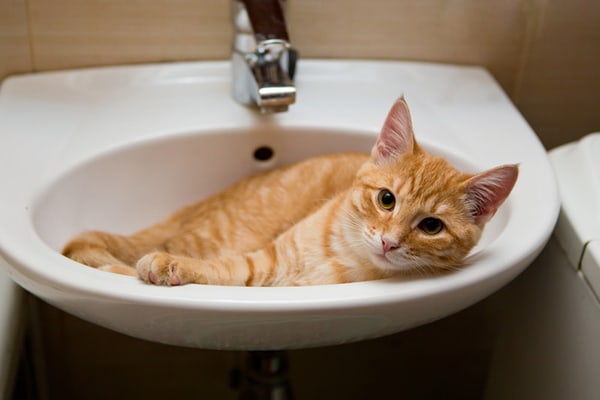More Cats but Less Cat Patients
 Most people don’t think their cat needs to see the vet unless they are obviously sick. Just like dogs – they need regular checkups. More households have cats than dogs and have more cats per household, but in most veterinary hospitals cats make up only about 1/3 of the patients. That statistic also applies to Clarksburg Animal Hospital. We want to improve those numbers and make sure our cats are as healthy as our dogs! Here’s how people think about cats:
Most people don’t think their cat needs to see the vet unless they are obviously sick. Just like dogs – they need regular checkups. More households have cats than dogs and have more cats per household, but in most veterinary hospitals cats make up only about 1/3 of the patients. That statistic also applies to Clarksburg Animal Hospital. We want to improve those numbers and make sure our cats are as healthy as our dogs! Here’s how people think about cats:- 81% of people think cats are more independent and self sufficient and don’t need as much attention. (The truth is that their symptoms are much more subtle and a vet can help find issues before they become more expensive problems.)
- 81% of people think their cats are in excellent health. (Nearly 60% of cats are overweight or obese, around 85% of cats over 4 have dental disease)
- 63% of people think Indoor Cats are not at risk of diseases. (Infectious disease and injuries are less, but dental disease, behavioral problems, obesity, diabetes, kidney disease, arthritis, inflammatory bowel disease are common conditions – no, vomiting cats are not normal!
Why don’t Cats see the Vet?
- Their symptoms are much more subtle than dogs.
- They don’t enjoy traveling.
- Many humans are less bonded with their cats than their dogs.
Common Cat Conditions – We Can HELP!!!
Cats (even indoor cats!) tend to suffer in relative silence and it is harder to recognize they are having trouble. We can help you with all of these potential problems. We help to identify potential issues before they are severe Prevention and early detection of disease is the key to keeping your cat happy and healthy and saving money. A diagnosis later in the stage of disease is often more expensive. Here are some of the more common problems we see in cats:
- Dental Problems (they will still eat even with bad teeth!)
- Arthritis (they still jump up, just a little less often and with more thought)
- Inflammatory Bowel Disease (no, vomiting isn’t normal)
- Weight Management (lots of our cats are chubby & there’s easy ways to help)
- Urinary Issues (once we diagnose it , we can treat it!)
- Behavior Issues (we’ll rule out medical reasons and then help with modification)
- Illness/Organ Failure (eating slightly less and/or losing weight)
Watch below for an excellent video of tips for taking your cat to the vet:
Stress Management tips for Cats (and their Humans)
The Human
- Take some deep breaths and remain calm. Once you are nervous, you cat will sense that and assume there is something to be afraid of happening.
- Give yourself plenty of time so you don’t feel pressured.
- Consider catching your cat earlier in the day and place them in a smaller room where you can catch them more easily when it is time. Ideally make this a room without hiding places out of your reach. For some cats it is better to shut all room doors and leave them out in the main space. Find what works for your home and cat.
- If it isn’t working, don’t turn it into a giant battle between you and your cat. Once you are both wound up, they are not going to have a pleasant or positive experience. If they aren’t sick or in need of immediate care, just call us to reschedule.
The Carrier
- Get the carrier out now and make it a good place with food, treats, toys, and familiar smells (blankets, your clothing).
- Better yet, find a place to leave the carrier out all the time so it is a fun and trusted space that provides a sense of security for them as they leave home.
- Put a familiar blanket, a shirt of yours for a familiar smell.
- Bring them to the appointment hungry – they are more likely to take treats in the carrier and from us.
- Carry the carrier gently – don’t tip and bang it! Think baby carrier, not amusement park!
Watch below for an informative video to help carrier train your cat:
The Car Ride
- Place the Carrier in a secure position, preferably where they can see you.
- Keep the radio quieter – those ears are sensitive. Try classical music at a low level.
- Take turns, acceleration and braking in a gentle fashion – Once again – sleeping baby in the car, not amusement park ride.
- Offer more treats before you start driving.
Coming into the Office
- Carry the carrier gently – don’t tip and bang it! Think baby carrier, not amusement park!
- Avoid setting the carrier on the floor. Cats feel safer when they are up high and can see what is going on around them.
- We will move you to a room quickly to avoid the stress of seeing and smelling other pets in the office.
- Set the carrier on the table (we’ll have a blanket sprayed with calming pheromones) and open the door. Leave them alone to look around and get acclimated. Cats do better when they’ve had a few minutes to take in their surroundings (sights, sounds & smells). If they want to come out and explore, let them.
- Offer more treats if you brought some favorites from home.
How We Help Make Your Visit Smoother
- A fresh clean towel with a calming pheromone spray on the table.
- We come in and chat with you a bit and let your cat get acclimated to us before we begin touching them.
- We can offer treats of ours or their favorite ones you brought.
- Some cats are more comfortable in their own space (ie – the carrier). We can take the top off and do their exam while they remain in a safe, familiar place.
- If we take them out of the carrier, we bring them out carefully and gently – no shaking and dumping out of the box!
- We try to keep them facing you which also makes them more comfortable.
- We only use as much restraint as needed. Every cat’s response is different and most only need minimal restraint for examinations.
- Some cats need a little extra help from medications that are designed to reduce anxiety and stress. We’ll suggest them if we feel it could help.




